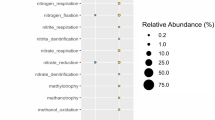Abstract
The purpose of this study was to compare the metabolic diversity of the whole microbial community in an oligotrophic saltern (Eilat, Israel) and in a saltern with a more enriched source water (Newark, California). Between 1993 and 1998 water samples were taken from selected locations within the solar salterns of the Cargill Solar Salt Plant, Newark, California, and the Israel Salt Co. in Eilat, Israel. To examine the whole community metabolic diversity, we used the 96-well BIOLOG GN{ TM} plates which contain 95 different carbon sources and a control well. Plates from samples containing greater than 15% salt were excluded from the final analyses because of a lack of reproducibility when multiple plates were inoculated with the same sample. The data were analyzed by simple matching coefficient and principal component analysis. Both methods gave similar results. Two major clusters were formed. These could be subdivided into 10 sub-clusters with only three samples from the Newark saltern in December 1997 joining at the 95% similarity level. Most of the inlet and lower salinity samples from the Cargill samples comprised one large subcluster. Several carbon sources were used by 85% of the microbial community from the California samples, while 85% of the Eilat samples had no commonly used carbon sources. These results suggest that ponds in different geographic locations may have communities with different microbial populations despite the similarities in salt content and processing for salt production.
Similar content being viewed by others
References
Duineveld, A. M., A. S. Rosado, J. D. van Elsas & J. A. van Veen, 1998. Analysis of the dynamics of bacterial communities in the rhizosphere of the chrysanthemum via denaturing gradient gel electrophoresis and substrate utilization patterns. Appl. envir. Microbiol. 64: 4950–4957.
Garland, J. L., 1996a. Analytical approaches to the characterization of samples of microbial communities using patterns of potential C source utilization. Soil Biol. Biochem. 28: 213–221.
Garland, J. L., 1996b. Patterns of potential C source utilization by rhizosphere communities. Soil Biol. Biochem. 28: 223–230.
Garland, J. L., 1997. Analysis and interpretation of community-level physiological profiles in microbial ecology. FEMS microbiol. Ecol. 24: 289–300.
Garland, J. L. & A. L. Mills, 1991. Classification and characterization of heterotrophic microbial communities on the basis of patterns of community-level sole-carbon source utilization. Appl. envir. Microbiol. 57: 2351–2359.
Garrigues, S. S., 1881. Statistics relating to the saline interests of Michigan. W. S. George & Co., State Printers and Binders, Lansing, pp. 13–15.
Gonzalez, C., C. Gutierrez & C. Ramirez, 1978. Halobacterium vallismortis sp. nov. An amylolytic and carbohydrate-utilizing extremely halophilic bacterium. Can J. Microbiol. 24: 710–715.
Haack, S. K., H. Garchow, M. J. Klug & L. J. Forney, 1995. Analysis of factors affecting the accuracy, reproducibility, and interpretation of microbial community carbon source utilization patterns. Appl. envir. Microbiol. 61: 1458–1468.
Hitzl, W., A. Rangger, S. Sharma & H. Insam, 1997. Separation power of the 95 substrates of the BIOLOG system determined with various soils. FEMS microbiol. Ecol. 22: 167–174.
Javor, B. 1984. Growth potential of halophilic bacteria isolated form solar salt environments: Carbon sources and salt requirements. Appl. envir. Microbiol. 48: 352–360.
Konopka, A., L. Oliver & R. F. Turco, Jr., 1998. The use of carbon substrate utilization patterns in environmental and ecological monitoring. Microbial Ecol. 35: 103–115.
Kovach, W. L. 1999. A MultiVariate Statistical Package for Windows, ver. 3.1. Kovach Computing Services, Pentraeth, Wales, United Kingdom.
Litchfield, C. D. & Oren, A., 2001. Polar lipids and pigments as biomarkers for the study of the microbial community structure of solar salterns. Hydrobiologia 466 (Dev. Hydrobiol. 162): 81–89.
Litchfield, C. D., A. Irby & R. H. Vreeland, 1999. The microbial ecology of solar salt plants. In Oren, A. (ed.), Microbiology and Biogeochemistry of Hypersaline Environments. CRC Press, Boca Raton, FL: 39–54.
Pierce, G. J., 1914. The behavior of certain micro-organisms in brine. Carnegie Inst. Washington Pub. 193: 49–69.
Quesada, E., A. Ventosa, F. Rodríguez-Valera, L. Megias & A. Ramos-Cormenzana, 1983. Numerical taxonomy of moderately halophilic gram-negative bacteria from hypersaline soils. J. gen. Microbiol. 129: 2649–2657.
Rodríguez-Valera, F., F. Ruiz-Berraquero & A. Ramos-Cormenzana, 1980. Isolation of extremely halophilic bacteria able to grow in defined inorganic media with single carbon sources. J. gen. Microbiol. 119: 535–538.
Rodríguez-Valera, F., F. Ruiz-Berraquero & A. Ramos-Cormenzana, 1981. Characteristics of the heterotrophic bacterial populations in hypersaline environments of different salt concentrations. Microb. Ecol. 7: 235–243.
Smalla, K., U. Wachtendorf, H. Heuer, W.-T. Liu & L. J. Forney, 1998. Analysis of BIOLOG GN substrate utilization patterns by microbial communities. Appl. envir. Microbiol. 64: 1220–1225.
Tomlinson, G. A. & L. I. Hochstein, 1976. Halobacterium saccharovorum sp. nov. a carbohydrate-metabolizing, extremely halophilic bacterium. Can. J. Microbiol. 22: 587–591.
Vreeland, R. H., C. D. Litchfield, E. L. Martin & E. Elliot, 1980. Halomonas elongata: A new genus and species of extremely salt tolerant bacteria. Int. J. syst. Bacteriol. 30: 485–495.
Winding, A., 1994. Fingerprinting bacterial soil communities using Biolog microtitre plates. In Ritz, K., J. Dighton, & K. E. Giller (eds), Beyond Biomass. John Wiley & Sons, New York: 85–94.
Winding, A. & N. B. Hendriksen, 1997. Biolog substrate utilization assay for metabolic fingerprints of soil bacteria: incubation effects. In Insam, H. & Rangger, A. (eds), Microbial Communities. Functional Versus Structural Approaches. Springer, Berlin: 195–205.
Wright, R. T. & J. E. Hobbie, 1965. The uptake of organic solutes in lake water. Limnol. Oceanogr. 10: 22–28.
Zak, J. C., M. R. Willig, D. L. Moorhead & H. G. Wildman, 1994. Functional diversity of microbial communities: A quantitative approach. Soil Biol. Biochem. 26: 1101–1108.
Author information
Authors and Affiliations
Rights and permissions
About this article
Cite this article
Litchfield, C.D., Irby, A., Kis-Papo, T. et al. Comparative metabolic diversity in two solar salterns. Hydrobiologia 466, 73–80 (2001). https://doi.org/10.1023/A:1014513317746
Issue Date:
DOI: https://doi.org/10.1023/A:1014513317746




